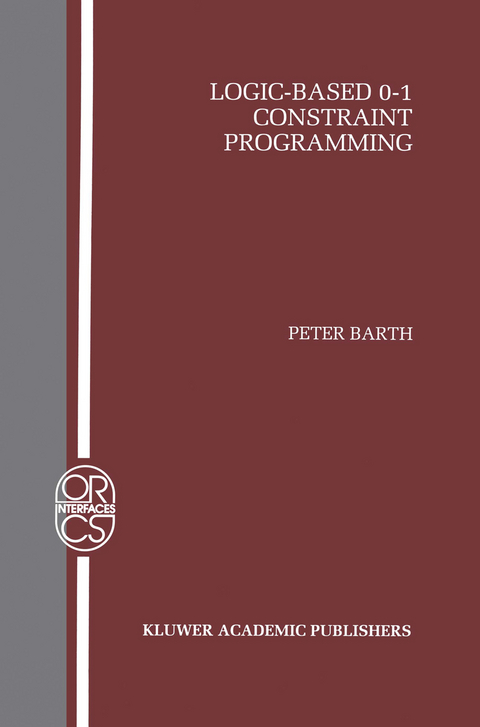
Logic-Based 0–1 Constraint Programming
Springer-Verlag New York Inc.
978-1-4612-8564-9 (ISBN)
Logic-based methods for modelling and solving combinatorial problems have recently started to play a significant role in both theory and practice. The application of logic to combinatorial problems has a dual aspect. On one hand, constraint logic programming allows one to declaratively model combinatorial problems over an appropriate constraint domain, the problems then being solved by a corresponding constraint solver. Besides being a high-level declarative interface to the constraint solver, the logic programming language allows one also to implement those subproblems that cannot be naturally expressed with constraints. On the other hand, logic-based methods can be used as a constraint solving technique within a constraint solver for combinatorial problems modelled as 0-1 integer programs.
1 Introduction.- 1.1 CLP and Combinatorial Optimization.- 1.2 Logic-based Pseudo-Boolean Constraint Solving.- 2 Constraint Logic Programming.- 2.1 CLP by Example.- 2.2 Semantics.- 2.3 Constraint Solving.- 2.4 Local Consistency and CLP.- 2.5 Logic Programming with Pseudo-Boolean Constraints.- 2.6 Existing CLP-systems for combinatorial optimization.- 3 Pseudo-Boolean Constraints.- 3.1 Preliminaries.- 3.2 Previous Work.- 3.3 Generalized Resolution.- 4 A Logic Cut Based Constraint Solver.- 4.1 The Solved Form.- 4.2 Reaching the Solved Form.- 5 Pseudo-Boolean Unit Resolution.- 5.1 The Classical Davis-Putnam Procedure.- 5.2 Davis-Putnam for Linear Pseudo-Boolean Inequalities.- 5.3 Optimizing with Pseudo-Boolean Davis-Putnam.- 5.4 Implementation.- 5.5 Heuristics.- 5.6 Computational Results.- 5.7 Pseudo-Boolean Davis-Putnam for CLP.- 6 Logic Cuts and Enumeration.- 6.1 Valid Extended Clauses by Enumeration.- 6.2 A Pure Logic Cut Algorithm.- 6.3 Entailment and Logic Cuts.- 7 Linear Pseudo-Boolean Inequalities and Extended Clauses.- 7.1 Generating Valid Extended Clauses.- 7.2 Identifying Redundant Extended Clauses.- 7.3 Implementation.- 7.4 Symmetries.- 7.5 Detection of Fixed Literals.- 7.6 Constrained Simplification.- 7.7 Cut Generation for 0–1 Integer Programming.- 7.8 Implementing Resolution.- 8 Simplification.- 8.1 An Order for Extended Clauses.- 8.2 Simplifying Diagonal Sums.- 8.3 Simplifying Resolvents.- 8.4 Equations between Literals.- 9 Linearization.- 9.1 Previous Work.- 9.2 A Linearization Method.- 9.3 Deriving Lower Bounds.- 9.4 Further Improvements.- 10 Projection.- 10.1 Projection for Prime Extended Clauses.- 10.2 Projection for Extended Clauses.- 10.3 Improvements.- 11 Conclusion.- 11.1 Summary of Results.- 11.2 Related and Future Research.- References.
| Reihe/Serie | Operations Research /Computer Science Interfaces Series ; 5 |
|---|---|
| Zusatzinfo | XIV, 254 p. |
| Verlagsort | New York, NY |
| Sprache | englisch |
| Maße | 155 x 235 mm |
| Themenwelt | Informatik ► Theorie / Studium ► Künstliche Intelligenz / Robotik |
| Mathematik / Informatik ► Mathematik ► Algebra | |
| Mathematik / Informatik ► Mathematik ► Angewandte Mathematik | |
| Mathematik / Informatik ► Mathematik ► Finanz- / Wirtschaftsmathematik | |
| Wirtschaft ► Allgemeines / Lexika | |
| Wirtschaft ► Betriebswirtschaft / Management ► Unternehmensführung / Management | |
| ISBN-10 | 1-4612-8564-X / 146128564X |
| ISBN-13 | 978-1-4612-8564-9 / 9781461285649 |
| Zustand | Neuware |
| Haben Sie eine Frage zum Produkt? |
aus dem Bereich


